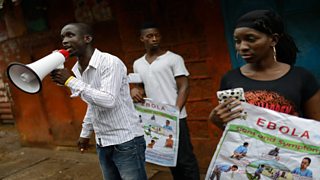Love in the time of Ebola
Yvonne MacPherson
Executive Director, �������� Media Action USA
It’s not a stretch of the imagination to consider the potential risk posed by global health threats to us all. We’ve just seen how Ebola impacted the region of West Africa and scared people much further afield. We also remember SARS, bird flu and others, and then there’s the prospect of bioterrorism. As the eminent epidemiologist says, outbreaks are inevitable but pandemics are optional. He asserts that the difference between an outbreak and a pandemic is the speed and effectiveness of the response.
Last week, a group of experts gathered at the Rockefeller Foundation’s historic in northern Italy to talk about the distinct role that communication plays in response efforts to global health crises. I was privileged to be a part of this group that was asked to envisage a future where the international community can be better prepared for outbreaks.
It’s an issue made all the more salient by the Ebola crisis. Media and communications provided life-saving information and a place for at-risk communities to interact with health and government officials, but it also helped to perpetuate rumour and misinformation, fuelling risk which spreads the virus.
Why is communication often overlooked in an emergency response? It can encourage positive behaviours to mitigate risks, provide locally relevant information when emergencies arise, and provide a platform for greater accountability in service provision.
Time and again we see that the first initiatives are to move in with treatment facilities, medical personnel and equipment. Communicating with the affected and at-risk communities is often an afterthought.
This may be because being seen to respond is as important as responding. It’s easier to demonstrate that something is being done when you can count the number of doctors deployed or protective gloves distributed. However, the perilous journey from outbreak to pandemic is determined by more than just the availability of diagnostic and treatment facilities.
that families would ignore calls to seek treatment for symptoms or abstain from traditional burial practices, not because of the lack of health equipment or burial teams, but because of behavioural determinants that can’t be easily measured or shipped in a logo-stamped container; things like love, fear, judgement and faith.
For example, we understood that many who conducted unsafe traditional burial practices, such as washing a corpse, did so even though they knew it was risky; the alternative meant sending a loved one off without proper care, consigning them to an undesirable afterlife and possible negative consequences for those left behind.
Even in a health crisis as dire as Ebola, we need to be compelled to access health services on a rational and emotional level. The principles of supply and demand apply. This is also famously apparent in the global attempts to eradicate polio. A vaccine is readily available, but getting people to accept the vaccination is the last – and highest – hurdle.
Here’s where communications has a critical role to play. Well researched and designed social and behaviour change communication, along with amplifying trusted voices from the affected communities, can help to address the barriers and facilitators to desired behaviour. One of the main conclusions coming out of the Ebola crisis is that community engagement helped stem the spread of the virus.

The Bellagio group agreed that to prepare better for future public health crises, communication should be integrated into global resilience and response strategies.
A perceived barrier in this is that some who determine global response priorities and budgets still require convincing that communication inputs are essential.
Our shortcoming as a field is that we need to improve the evidence base that shows investing in communications actually helps prevent further human suffering and fatalities. Luckily, �������� Media Action has something to contribute here. We recently published a research report, , which examines the state of the evidence in emergency communications and presents case studies covering responses to the Ebola epidemic, the earthquakes in Nepal this year and other emergencies.
Conducting robust research in a crisis is part of the challenge, marked by a lack of access to affected communities or baseline data, and time and resource constraints. There are also clear ethical considerations: it wouldn't be acceptable to set up a counterfactual or control group that would not receive aid.
As a result we need to be creative and try new approaches. �������� Media Action experimented with SMS polls to measure the impact of our Ebola radio programmes in West Africa at a time when randomly selected household surveys would have been unsafe and inappropriate. These polls revealed that radio helped inform and influence preventive health practices and showed that listeners valued hearing solutions from local voices across the region.
My hope is that those who are working on the reform of the international community's response to global health emergencies see communication as aid. I thank the Rockefeller Foundation for making the issue of communications in resilience and response a priority and hope that our combined efforts help prevent the next pandemic.
Related links
Follow �������� Media Action on and
